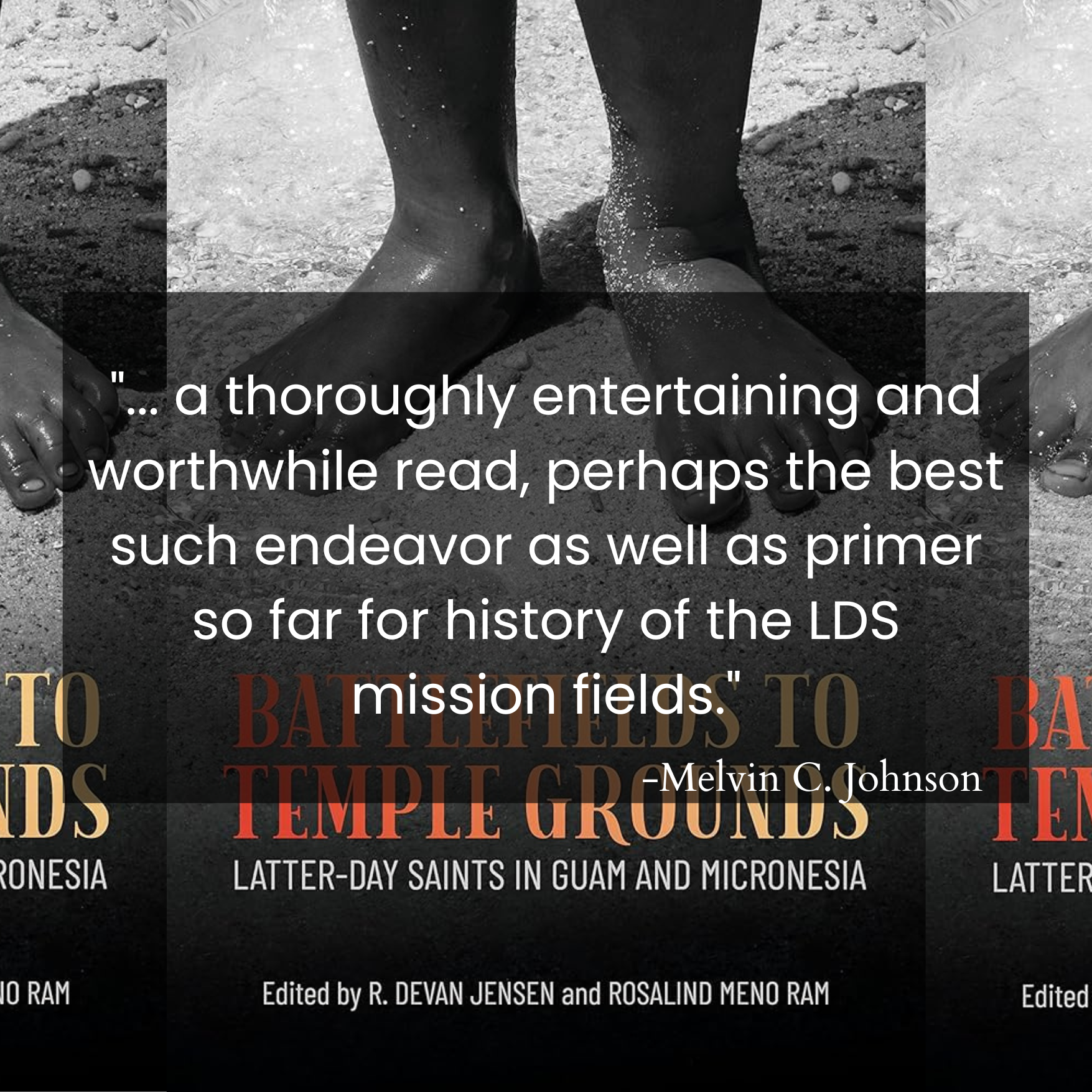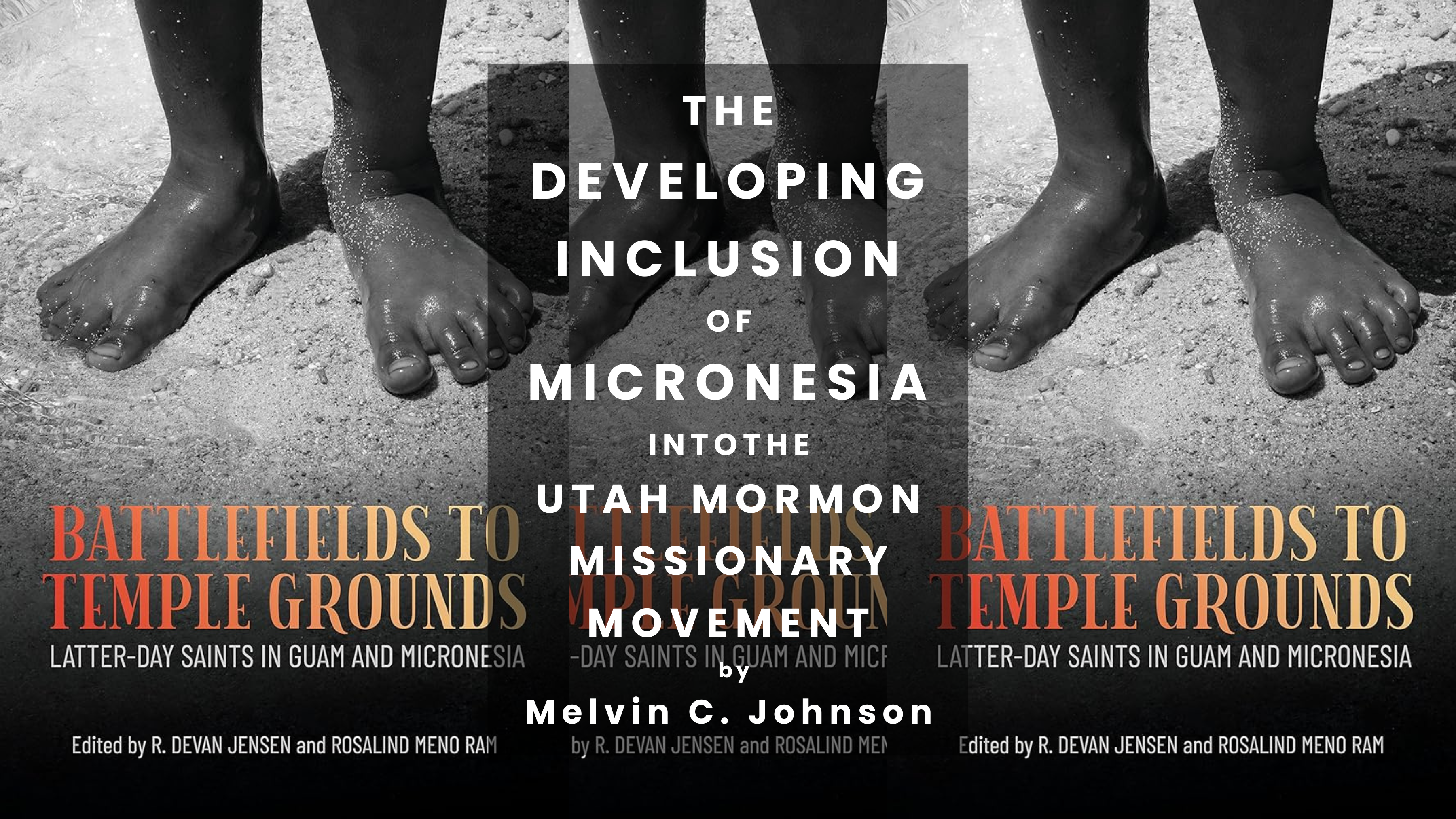Articles/Essays – Volume 57, No. 1
The Developing Inclusion of Micronesia into the Utah Mormon Missionary Movement | R. Devan Jensen and Rosalind Meno Ram, eds., Battlefields to Temple Grounds: Latter-day Saints in Guam and Micronesia
Since the 1840s, the leadership and members of the Church of Jesus Christ of Latter-day Saints, even with its global missionary program, has been centered with a focus on the North American Great Basin westward to California. Inevitably, the history and biography of the LDS Church and its members have mostly emphasized the foundational events of the great move and the colonization of Utah Territory and adjacent regions. However, the missionary outreach to the world has shouldered its way into the literature of culture, history, and politics of members far and away from “Zion” at home. Battlefields to Temple Grounds: Latter-day Saints in Guam and Micronesia is a thoroughly entertaining and worthwhile read, perhaps the best such endeavor as well as primer so far for history of the LDS mission fields. The studies of scholars led by R. Devan Jensen and Rosalind Meno Ram chronicle the Church’s entry and into Micronesia in the vastness of the Pacific.
Battlefields to Temple Grounds generates a unique record of the Indigenous cultures of Micronesia and their intersections with the colonial imperialism of the nations of Europe, Asia, and the United States. The extensive narrative extends from Magellan’s landing in the early sixteenth century. The major emphasis explores and explains the coming of Saints to Micronesia in the Pacific battles of World War II and develops the presence and growth of the Church to the present day in Kiribati, the Marshall Islands, Saipan, Guam, Truk (Chuuk), Pohnpei, Palau, Yap, and many other islands.[1]
Latter-day Saint missionaries came to Micronesia in the 1960s. Protestant and Catholic missionaries came much earlier. As sea currents intermingle as they roll across the ocean, strong waves of colonial cultures, Christian and non-Christian, vigorously challenged and interacted with the Indigenous cultures. European, Asian, and American nations variously claimed or colonized the islands and peoples, exerting influence in politics, education, and the economy, treating the islands and inhabitants as strategic bases or resources. The imperialists influenced the political affairs and policies, the instruction of the Indigenous peoples, and the economic development of the islands, using them as military bases in the Great Game of global conquest for strategic position and resource extraction. The Indigenous people have reacted to each wave and adapted, intermingling civilizations and cultures. After Japan’s bombings of Hawaii and occupation of Guam and Wake Island, Latter-day Saint military personnel would enter Micronesia on the momentum of the American war effort. In the 1960s, LDS missionaries began teaching the military personnel and islanders, leading to the creation of the Micronesia Guam Mission and the Marshall Islands Majuro Mission, which includes Kiribati. And on these Pacific battlefields have developed peaceful temple grounds.

I appreciated how the writers developed a maturity of voice that strengthens and enriches the unity and continuity of the book’s themes. The first example is that of Marina and Ronnie Oei, who
were originally from New Guinea and of Indonesian ancestry but had raised most of their family in the Netherlands. A little while after her first dream, Marina received another important message in the night. I saw two men ring our doorbell. As I opened the door, I saw two young men standing wearing blue suits and white shirts with a name tag. I heard a voice say, “Do not close your door, but let them in and listen to what they have to say to you.” The next day, I and my husband went to visit his niece. When we came home, my son Richard said someone called and asked, “Is this the Oei family?” My son said, “Yes, but my parents aren’t home.” So the person told my son that they would come the next day at 11 a.m. My son said the person spoke English, so I prepared a meal for them and waited that Saturday. When someone rang our doorbell, I opened the door and saw two young men; one of them looked like the one I saw. (186)
The inclusion of Indigenous voices endows authentic history.
The book may well begin a young missionary’s search on how to succeed in differing cultures. Having listened to many returned missionary reports, I finally have had to accept that a Mormon white savior complex, although well-meaning, is a real thing. The book can instruct how to deal with the fact that s/he is the “other” in the mission field, not the local inhabitants. The world’s intrinsic values in regional cultures inevitably move and motivate the community’s inhabitants’ social and cultural pathways. The quicker the young missionary (or senior service missionary, for that matter) can adopt and exhibit an inclusive viewpoint, the experience will become richly rewarding.
The book is timely and worthy and demands that it should attract a large readership. I have no doubt that those who read it will recommend it to others. It teaches lessons in having to surmount societal chasms of misunderstanding in language as well as cultural and racial prejudices. The work uniquely directs the reader to inspect one’s own personality and relationship with Christ when in contact and conflict with the “other.” It becomes a measure of the reader’s personality.
You want this book on your shelf at home and in the office. I want it on my Kindle, which is either in my pocket or on the night stand next to my bed for when those niggling questions come in the night; and they will.
R. Devan Jensen and Rosalind Meno Ram, eds. Battlefields to Temple Grounds: Latter-day Saints in Guam and Micronesia. BYU Religious Studies Center, Jonathan Nāpela Center for Hawaiian and Pacific Islands Studies, and Deseret Book, 2023. 320 pp. Paper: $24.99. ISBN: 9781950304363
[1] Ironically, my father (US Army) and stepfather (US Marines) participated in the Mariana Campaigns at Guam and Saipan, respectively. They would later be converted to the LDS Church after the war. My father never stepped onto Guam, his invasion craft having been mortar shelled offshore, every man killed or wounded. He woke up in a hospital ship.


 Back to full Issue
Back to full Issue

